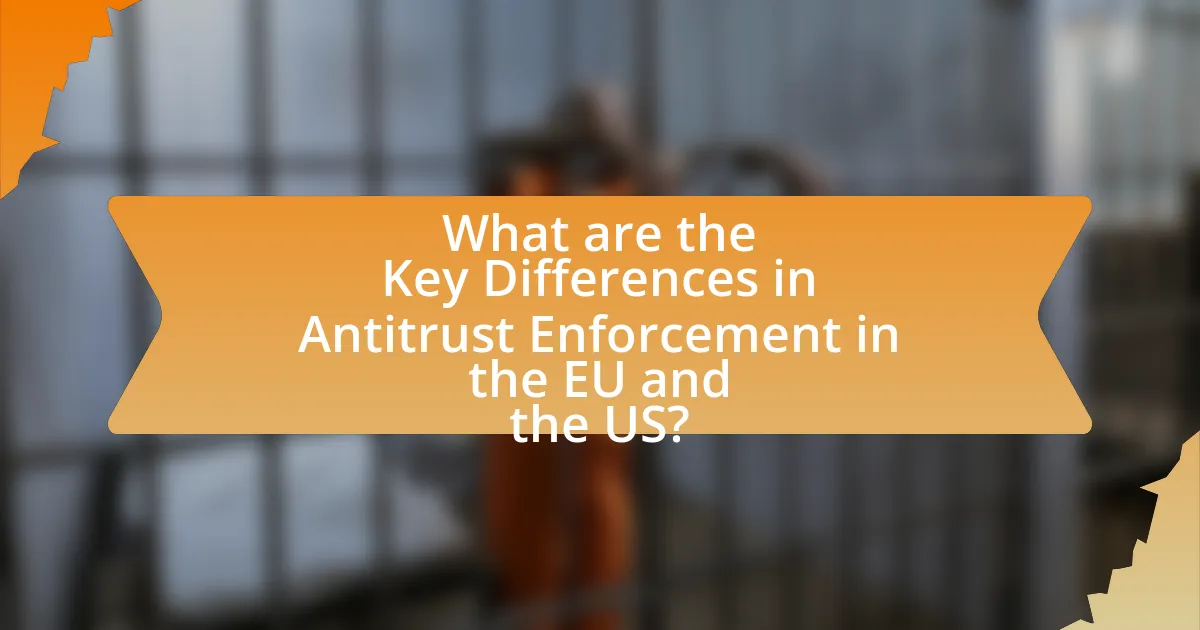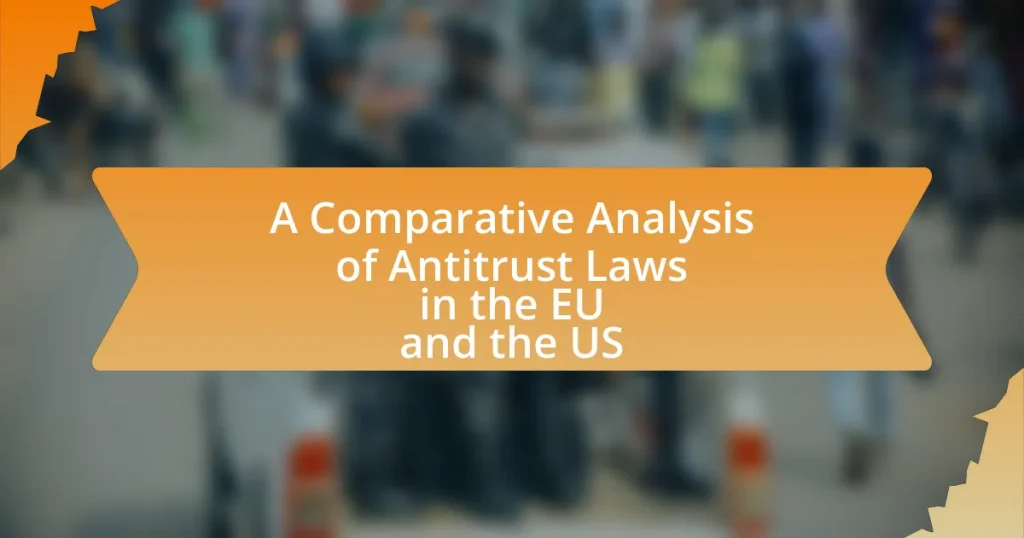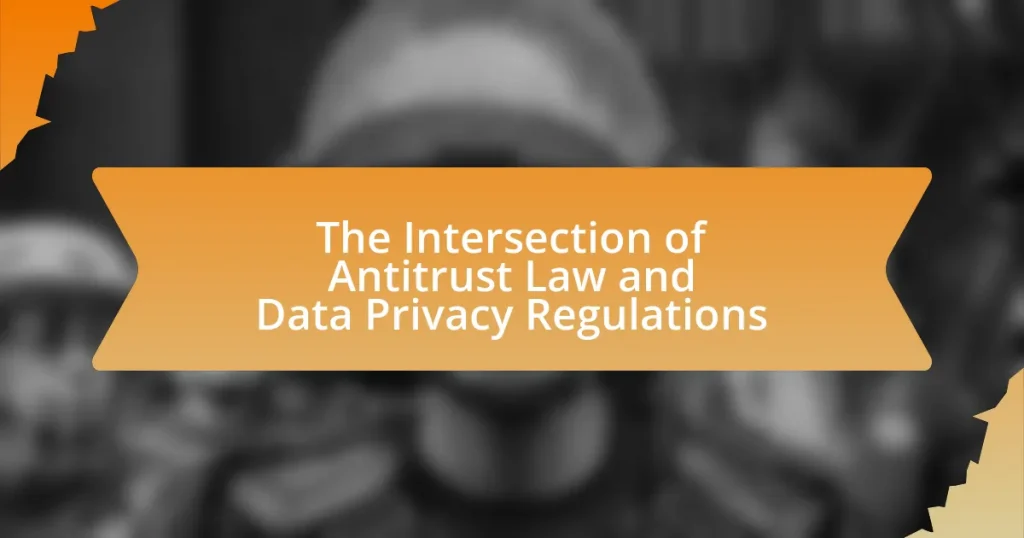Antitrust laws are critical regulations aimed at promoting competition and preventing monopolistic practices in both the European Union (EU) and the United States (US). This article provides a comparative analysis of antitrust laws in these two regions, highlighting their historical development, key objectives, and enforcement mechanisms. It examines landmark cases that have shaped antitrust regulations, such as the Sherman Act in the US and the EU’s competition laws, and discusses the implications for businesses operating in these jurisdictions. Additionally, the article outlines the differences in enforcement approaches between the EU and the US, emphasizing the importance of compliance for companies to avoid legal repercussions.

What are Antitrust Laws and Why are They Important?
Antitrust laws are regulations designed to promote competition and prevent monopolistic practices in the marketplace. These laws are important because they protect consumers from unfair business practices, ensure a level playing field for businesses, and foster innovation by preventing dominant companies from stifling competition. For instance, the Sherman Act of 1890 in the United States prohibits monopolistic behavior and has been instrumental in breaking up large corporations that engage in anti-competitive practices. Similarly, the European Union’s competition laws, such as Article 101 and Article 102 of the Treaty on the Functioning of the European Union, aim to prevent anti-competitive agreements and abuse of market dominance. The enforcement of these laws is crucial for maintaining economic fairness and consumer choice.
How do Antitrust Laws differ between the EU and the US?
Antitrust laws in the EU and the US differ primarily in their approach to market competition and consumer welfare. The EU emphasizes protecting market structure and preventing monopolistic practices, focusing on maintaining competition as a means to benefit consumers, as seen in regulations like the EU Merger Regulation. In contrast, US antitrust laws, particularly the Sherman Act, prioritize consumer welfare, often assessing the effects of business practices on prices and output rather than on market structure alone. This distinction is evident in landmark cases, such as the EU’s action against Google for abuse of dominance, which focused on maintaining competitive market conditions, while the US has historically allowed more leeway for mergers that do not significantly harm consumer prices.
What historical events shaped Antitrust Laws in the EU?
The historical events that shaped Antitrust Laws in the EU include the establishment of the European Economic Community (EEC) in 1957, which laid the groundwork for competition policy, and the adoption of the Treaty of Rome, which included provisions against anti-competitive practices. The 1970s saw the introduction of Regulation 17, the first regulation implementing the competition rules of the Treaty of Rome, which marked a significant step in enforcing antitrust laws. Additionally, the 1990s brought about the modernization of EU competition law, culminating in the adoption of the 2004 Regulation 1/2003, which enhanced the enforcement of antitrust rules by allowing national authorities to apply EU competition law. These events collectively established a robust framework for regulating competition within the EU, reflecting the region’s commitment to maintaining a competitive market.
What historical events shaped Antitrust Laws in the US?
The Sherman Antitrust Act of 1890 was a pivotal historical event that shaped Antitrust Laws in the US. This legislation aimed to combat monopolistic practices and promote competition by prohibiting contracts, combinations, or conspiracies in restraint of trade. The enforcement of the Sherman Act was significantly influenced by the rise of large corporations and trusts in the late 19th century, which led to public outcry against monopolies that stifled competition and harmed consumers. Subsequent events, such as the establishment of the Federal Trade Commission in 1914 and the Clayton Antitrust Act of 1914, further defined and expanded antitrust regulations, addressing issues like price discrimination and exclusive dealings. These legislative milestones collectively laid the foundation for modern antitrust enforcement in the United States.
What are the main objectives of Antitrust Laws?
The main objectives of antitrust laws are to promote competition, prevent monopolies, and protect consumers from anti-competitive practices. These laws aim to ensure a fair marketplace by prohibiting practices such as price-fixing, market allocation, and monopolistic behaviors that can harm consumer choice and inflate prices. For instance, the Sherman Act of 1890 in the United States established foundational principles against monopolistic practices, while the European Union’s Competition Law, particularly Articles 101 and 102 of the Treaty on the Functioning of the European Union, similarly seeks to prevent anti-competitive agreements and abuse of dominant market positions.
How do Antitrust Laws promote competition?
Antitrust laws promote competition by prohibiting anti-competitive practices such as monopolies, price-fixing, and collusion among businesses. These laws ensure a level playing field, allowing new and smaller companies to enter the market and compete effectively against established firms. For example, the Sherman Act in the United States and the Treaty on the Functioning of the European Union in the EU both aim to prevent market dominance that stifles competition. Historical enforcement actions, such as the breakup of AT&T in the 1980s, illustrate how antitrust laws can dismantle monopolistic structures, thereby fostering a more competitive environment that benefits consumers through lower prices and increased innovation.
What role do Antitrust Laws play in consumer protection?
Antitrust laws play a crucial role in consumer protection by promoting competition and preventing monopolistic practices that can harm consumers. These laws, such as the Sherman Act in the United States and the Treaty on the Functioning of the European Union in Europe, are designed to ensure that markets remain open and competitive, which leads to lower prices, improved quality, and greater innovation. For instance, the Federal Trade Commission reported that increased competition resulting from antitrust enforcement can lead to price reductions of up to 20% in certain markets. By curbing anti-competitive behavior, antitrust laws safeguard consumer interests and enhance overall market efficiency.

What are the Key Differences in Antitrust Enforcement in the EU and the US?
The key differences in antitrust enforcement between the EU and the US lie in their legal frameworks and enforcement approaches. The EU employs a more regulatory and precautionary approach, focusing on preventing anti-competitive behavior before it occurs, as evidenced by the European Commission’s proactive investigations and fines, such as the €2.42 billion fine imposed on Google in 2017 for abusing its market dominance. In contrast, the US system, governed primarily by the Sherman Act and the Clayton Act, emphasizes a more permissive stance, allowing for greater market freedom and focusing on consumer welfare, as demonstrated by the Federal Trade Commission’s (FTC) historical reluctance to intervene unless clear harm to consumers is evident. Additionally, the EU’s enforcement is centralized under the European Commission, while the US has a decentralized approach with multiple agencies, including the FTC and the Department of Justice, leading to variations in enforcement priorities and outcomes.
How is Antitrust enforcement structured in the EU?
Antitrust enforcement in the EU is primarily structured around the European Commission, which is responsible for investigating and enforcing competition laws under Articles 101 and 102 of the Treaty on the Functioning of the European Union (TFEU). The European Commission has the authority to conduct investigations, impose fines, and require companies to cease anti-competitive practices. Additionally, national competition authorities in EU member states also play a significant role in enforcing competition laws, often collaborating with the European Commission on cases that have cross-border implications. This dual-layered enforcement system ensures that both EU-wide and national competition issues are addressed effectively.
What institutions are responsible for Antitrust enforcement in the EU?
The primary institutions responsible for antitrust enforcement in the EU are the European Commission and national competition authorities of EU member states. The European Commission, specifically its Directorate-General for Competition, is tasked with enforcing EU competition law, including investigating anti-competitive practices and mergers. National competition authorities, such as the Bundeskartellamt in Germany and the Autorité de la concurrence in France, also enforce competition laws at the national level, often cooperating with the European Commission on cross-border cases. This dual system ensures comprehensive enforcement of antitrust regulations across the EU.
What processes are involved in Antitrust investigations in the EU?
Antitrust investigations in the EU involve several key processes, including complaint assessment, preliminary investigation, formal investigation, and decision-making. Initially, the European Commission evaluates complaints from businesses or consumers regarding anti-competitive behavior. If sufficient grounds exist, a preliminary investigation is conducted to gather evidence. Should this investigation indicate potential violations, a formal investigation is initiated, allowing for in-depth analysis and the collection of further evidence, including inspections and requests for information. Finally, the Commission issues a decision, which may result in fines or orders to cease anti-competitive practices. These processes are governed by the EU’s competition rules, specifically Articles 101 and 102 of the Treaty on the Functioning of the European Union, ensuring a structured approach to maintaining market competition.
How is Antitrust enforcement structured in the US?
Antitrust enforcement in the US is primarily structured through federal and state laws, with key agencies responsible for enforcement being the Federal Trade Commission (FTC) and the Antitrust Division of the Department of Justice (DOJ). The Sherman Act of 1890, the Clayton Act of 1914, and the Federal Trade Commission Act of 1914 form the foundational legal framework for antitrust enforcement. The FTC investigates and prosecutes unfair methods of competition, while the DOJ focuses on criminal prosecutions for antitrust violations. Additionally, state attorneys general can enforce state antitrust laws, which often mirror federal statutes. This multi-layered approach ensures comprehensive oversight of competitive practices in the marketplace.
What institutions are responsible for Antitrust enforcement in the US?
The institutions responsible for antitrust enforcement in the US are the Federal Trade Commission (FTC) and the Antitrust Division of the Department of Justice (DOJ). The FTC is tasked with preventing unfair methods of competition and deceptive acts, while the DOJ enforces federal antitrust laws through civil and criminal actions. Both agencies work to promote competition and protect consumers, ensuring compliance with the Sherman Act, the Clayton Act, and the Federal Trade Commission Act.
What processes are involved in Antitrust investigations in the US?
Antitrust investigations in the US involve several key processes, including the initiation of investigations, data collection, analysis, and enforcement actions. The Federal Trade Commission (FTC) and the Department of Justice (DOJ) are the primary agencies responsible for these investigations.
Initially, investigations can be triggered by complaints from consumers, competitors, or through the agencies’ own monitoring. Once initiated, the agencies gather evidence through document requests, interviews, and subpoenas. This data collection phase is crucial for understanding the competitive dynamics of the market in question.
Following data collection, the agencies analyze the information to determine whether there is sufficient evidence of anticompetitive behavior, such as monopolization or collusion. If evidence is found, the agencies may pursue enforcement actions, which can include filing lawsuits to block mergers, impose fines, or seek other remedies.
The processes are governed by the Sherman Act, the Clayton Act, and the Federal Trade Commission Act, which provide the legal framework for identifying and addressing antitrust violations. Historical cases, such as the breakup of AT&T in the 1980s, illustrate the application of these processes in practice.

What are the Major Cases that Highlight Antitrust Laws in the EU and the US?
Major cases that highlight antitrust laws in the EU and the US include the Microsoft case in the US and the Google Shopping case in the EU. The Microsoft case, initiated in 1998, focused on the company’s monopolistic practices related to its Windows operating system, leading to a settlement that imposed restrictions on Microsoft’s business practices. In the EU, the Google Shopping case, which concluded in 2017, resulted in a €2.42 billion fine for Google due to its abuse of market dominance by favoring its own comparison shopping service over competitors. These cases exemplify the enforcement of antitrust laws aimed at promoting competition and preventing monopolistic behavior in both jurisdictions.
What landmark Antitrust cases have occurred in the EU?
Landmark antitrust cases in the EU include the Microsoft case, the Google Shopping case, and the Intel case. In the Microsoft case (2004), the European Commission fined Microsoft €497 million for abusing its dominant market position by bundling its media player with Windows. The Google Shopping case (2017) resulted in a €2.42 billion fine for Google for favoring its own shopping service in search results, which was deemed anti-competitive. The Intel case (2009) involved a €1.06 billion fine against Intel for providing rebates to computer manufacturers to exclude competitors, which violated EU competition laws. These cases illustrate the EU’s rigorous enforcement of antitrust regulations to maintain market competition.
What were the outcomes of these landmark cases?
The outcomes of landmark antitrust cases in the EU and the US significantly shaped competition law in both jurisdictions. In the US, cases like United States v. Microsoft Corporation resulted in a settlement that imposed restrictions on Microsoft’s business practices, promoting competition in the software market. In the EU, the European Commission’s decision against Google in 2017 led to a record fine of €2.42 billion and mandated changes to its search practices, reinforcing the EU’s stringent approach to antitrust enforcement. These cases illustrate the differing regulatory philosophies, with the US focusing on consumer welfare and the EU emphasizing market fairness and competition.
How did these cases influence future Antitrust regulations in the EU?
The cases significantly influenced future Antitrust regulations in the EU by establishing precedents that shaped the enforcement and interpretation of competition law. For instance, the European Court of Justice rulings in landmark cases such as the Continental Can case in 1973 and the Hoffmann-La Roche case in 1979 clarified the scope of Article 101 of the Treaty on the Functioning of the European Union, emphasizing the prohibition of anti-competitive agreements and abuse of dominant positions. These rulings led to a more rigorous approach in assessing mergers and acquisitions, as seen in the 2004 merger regulation reform, which introduced stricter scrutiny of market dominance and anti-competitive practices. Consequently, these cases laid the groundwork for a more proactive regulatory framework, ensuring that future antitrust policies in the EU would prioritize consumer welfare and market competition.
What landmark Antitrust cases have occurred in the US?
Landmark antitrust cases in the US include the Sherman Antitrust Act case against Standard Oil in 1911, which resulted in the breakup of the company for monopolistic practices. Another significant case is United States v. Microsoft Corp. in 2001, where Microsoft was found to have engaged in anti-competitive behavior by bundling its software products. Additionally, the case of United States v. AT&T in 1982 led to the breakup of the Bell System, which was deemed a monopoly in telecommunications. These cases illustrate the enforcement of antitrust laws aimed at promoting competition and preventing monopolies in the US economy.
What were the outcomes of these landmark cases?
The outcomes of landmark antitrust cases in the EU and the US significantly shaped competition law in both jurisdictions. In the US, cases like United States v. Microsoft Corporation resulted in a settlement that imposed restrictions on Microsoft’s business practices, promoting competition in the software market. In the EU, the European Commission’s decision against Google in 2017 led to a record fine of €2.42 billion and mandated changes to its search advertising practices, reinforcing the EU’s stringent approach to antitrust enforcement. These cases illustrate the differing regulatory philosophies, with the US focusing on consumer welfare and the EU emphasizing market fairness and competition.
How did these cases influence future Antitrust regulations in the US?
The landmark antitrust cases, such as United States v. Microsoft Corp. and United States v. AT&T, significantly influenced future antitrust regulations in the US by establishing precedents for evaluating monopolistic practices and promoting competition. These cases underscored the importance of scrutinizing corporate mergers and acquisitions, leading to stricter guidelines and enforcement actions by regulatory bodies like the Federal Trade Commission and the Department of Justice. For instance, the Microsoft case in the late 1990s set a benchmark for assessing anti-competitive behavior in the tech industry, resulting in increased regulatory vigilance and the adoption of more rigorous standards for market dominance. Consequently, these judicial outcomes shaped the evolution of antitrust laws, emphasizing the need for proactive measures to prevent anti-competitive practices and ensure consumer welfare.
What are the implications of Antitrust Laws for businesses operating in both regions?
Antitrust laws significantly impact businesses operating in both the European Union and the United States by imposing regulations that prevent anti-competitive practices. In the EU, the enforcement of these laws is stringent, with the European Commission actively investigating mergers and practices that may distort competition, as evidenced by the €4.34 billion fine imposed on Google in 2018 for antitrust violations. In the US, the Federal Trade Commission and the Department of Justice oversee antitrust enforcement, focusing on maintaining market competition, as demonstrated by the 2020 lawsuit against Google for monopolistic behavior. Consequently, businesses must navigate complex legal frameworks in both regions, ensuring compliance to avoid substantial penalties and potential operational restrictions.
How can businesses ensure compliance with Antitrust Laws in the EU?
Businesses can ensure compliance with Antitrust Laws in the EU by implementing robust compliance programs that include regular training, monitoring, and legal audits. These programs should be designed to educate employees about the specific provisions of EU competition law, such as Article 101 and Article 102 of the Treaty on the Functioning of the European Union, which prohibit anti-competitive agreements and abuse of market dominance, respectively.
Additionally, businesses should conduct thorough market analyses to identify potential anti-competitive practices and seek legal counsel to review business practices and agreements. The European Commission provides guidelines and resources that can assist in understanding compliance requirements, and businesses can also benefit from engaging with industry associations that offer compliance resources. Regularly updating compliance strategies in response to changes in legislation and case law is crucial for maintaining adherence to EU antitrust regulations.
How can businesses ensure compliance with Antitrust Laws in the US?
Businesses can ensure compliance with Antitrust Laws in the US by implementing robust compliance programs that include regular training, monitoring, and legal audits. These programs should educate employees about antitrust regulations, such as the Sherman Act and the Clayton Act, which prohibit anti-competitive practices. Regular audits help identify potential violations, while legal counsel can provide guidance on complex issues. According to the Federal Trade Commission, companies that proactively engage in compliance measures are less likely to face enforcement actions, demonstrating the effectiveness of such programs in mitigating legal risks.



